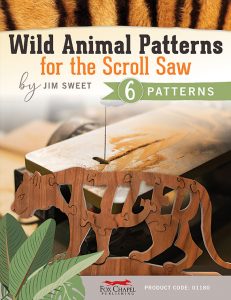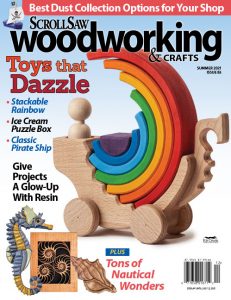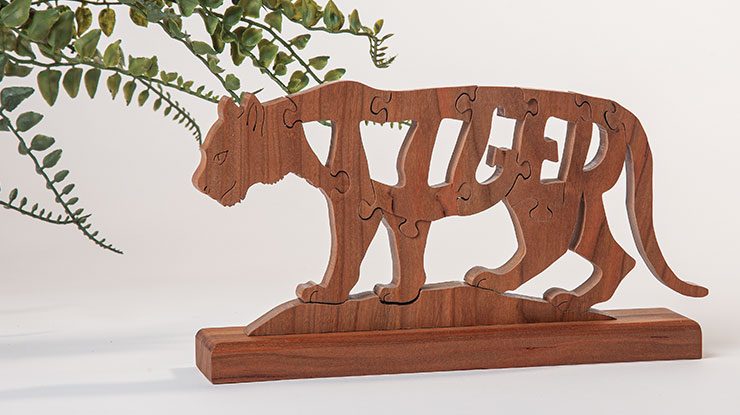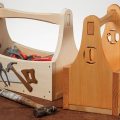Scroll a freestanding feline that’s perfect for display or play
Designed by Jim Sweet
Cut by John A. Nelson
If you love puzzles, animals, and word art, it’s your lucky day—I’ve devised a project that includes all three. (If you’re a cat person, even better!) Showcase your cutting abilities in elegant hardwood with a puzzle that kids and adults will love. If you prefer bland woods, such as pine, you could plan a fun crafting evening and let kids coat the surface of the cut pieces with colorful acrylic paints.
Note: If you’re giving this puzzle to a small child, consider omitting or woodburning a few of the cut lines to make the pieces safer for play.
Getting Started
Choose a kind of wood; I prefer fine-figured hardwoods, such as cherry and maple. I added a base to this design so the puzzle can be displayed, but you could leave this off, if desired. Cut the wood to size and sand with 80-grit sandpaper, working up progressively through the grits until you reach 220. Photocopy the pattern, cover the wood with blue painter’s tape, and then attach the pattern to the wood with spray adhesive. Drill the blade-entry holes (for example, the center of the R).
Cutting and Finishing
Cut the pieces on a scroll saw. Use a #5 reverse-tooth blade or whichever size and type seems appropriate to the wood variety and thickness of your stock. Note that the fur texture lines on the pattern are for paint reference only.
Remove the pattern and any excess sawdust. Gently soften the sharp edges with 220- and then 320-grit sandpaper in an orbital sander. Drill holes for the dowel in the rectangular base, up into the second base, and in the tiger’s front leg (the second one, when viewed from the side). This small addition will secure the entire assembly so it stands easily. Round over the edges on the base with a pneumatic drum sander or a 1/4″ (6mm)-dia. roundover bit in a router. Finish as desired; I prefer a natural Danish oil, but you can add painted details with thinned acrylics and then seal with a matte spray lacquer or similar. Once dry, test the dowel’s fit and adjust the length as necessary. Glue it into the base, attach the tiger, and display.
Materials
• Wood, such as cherry, 3/4″ (1.9cm) thick: tiger, 4 5/8″ x 10″ (11.7cm x 25.4cm)
• Wood, such as cherry, 3/4″ (1.9cm) thick: base, 2″ x 9 3/4″ (5.1cm x 24.8cm)
• Wood dowel, 1/8″ (3mm)-dia.: 2″ (5.1cm) long
• Tape: blue painter’s
• Spray adhesive
• Sandpaper: assorted grits to 220
• Wood glue
• Finish, such as matte spray lacquer or Danish oil
• Acrylic paints: assorted (optional)
Tools
• Scroll saw with blades: #5 reverse-tooth
• Drill press with bits: 1/16″ (2mm), 1/8″ (3mm)-dia.
• Sanders: orbital, pneumatic drum
• Router with bit: 1/4″ (6mm)-dia. roundover (optional)
• Paintbrushes (optional)
 Interested in more? Check out Wild Animal Patterns for the Scroll Saw by Jim Sweet. Each free-standing design uniquely spells the name of each animal–a Jim Sweet signature–and can be completed in just 20 minutes!
Interested in more? Check out Wild Animal Patterns for the Scroll Saw by Jim Sweet. Each free-standing design uniquely spells the name of each animal–a Jim Sweet signature–and can be completed in just 20 minutes!
About the Author
Jim Sweet is the inventor of the popular Woodimal puzzles. Jim and his wife, Lois, worked the craft show circuit for several years before deciding to focus on designing patterns. For more Woodimal patterns, visit foxchapelpublishing.com.
 |
Purchase our summer issue!
Purchase Our Summer Issue Here!
For more articles like these, subscribe to Scroll Saw Woodworking & Crafts magazine. SubscribePlus! Get mini magazines in your e-mail between printed issues with Short Cuts, our e-mail newsletter. |









